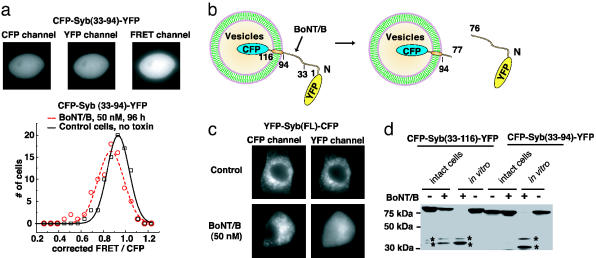Fig. 3.
Localization of Syb to vesicles is required for efficient cleavage by BoNT/B. (a) CFP-Syb(33–94)-YFP was expressed in a PC12 cell line that stably expresses synaptotagmin II (18). This sensor appears to be soluble inside cells and generates strong FRET signals (Upper). BoNT/B holotoxin was added to the culture medium, and 80 cells were analyzed after 96 h as described in Fig. 2b. Control cells, not treated with toxin, were analyzed in parallel. (b) A schematic description of the YFP-Syb(FL)-CFP toxin sensor. Full-length Syb is 116 aa long and is localized to vesicles through a single transmembrane domain. Cleavage of the sensor by BoNT/B should release the cytoplasmic domain of Syb, tagged with YFP, from the vesicle surface. (c) PC12 cells that stably express synaptotagmin II were transfected with YFP-Syb(FL)-CFP and incubated with (50 nM, 48 h, Lower), or without BoNT/B(Upper). CFP and YFP fluorescence images were collected for each cell, and representative cells are shown. YFP-Syb(FL)-CFP is localized to vesicles, and was excluded from the nucleus in living cells, as evidenced by both CFP and YFP fluorescent signals (Upper). BoNT/B treatment resulted in a redistribution of YFP, which became dispersed throughout the cytosol and entered the nucleus. (d) A truncated version of Syb, residues 33–116, was used to link CFP to YFP. This construct contains the same cytosolic region (residues 33–94) as the Syb fragment in the soluble sensor CFP-Syb(33–94)-YFP, but also contains the transmembrane domain of Syb (residues 95–116). PC12 cells that express synaptotagmin II were transfected with CFP-Syb(33–116)-YFP or CFP-Syb(33–94)-YFP. Cells were then incubated with (+, intact cells) or without (–, intact cells) BoNT/B (50 nM, 48 h) and harvested. Half of the cell lysates from samples that had not been exposed to BoNT/B were subsequently incubated with (+, in vitro) or without (–, in vitro) reduced BoNT/B in vitro. The same amount of each sample (30-μg cell lysate) was subjected to SDS/PAGE and immunoblot analysis using an anti-GFP antibody. Two cleavage products are indicated by asterisks. Whereas CFP-Syb(33–116)-YFP underwent significant cleavage in intact cells, there was no detectable cleavage of CFP-Syb(33–94)-YFP, indicating that the localization to vesicles is important for efficient cleavage by BoNT/B in living cells.

